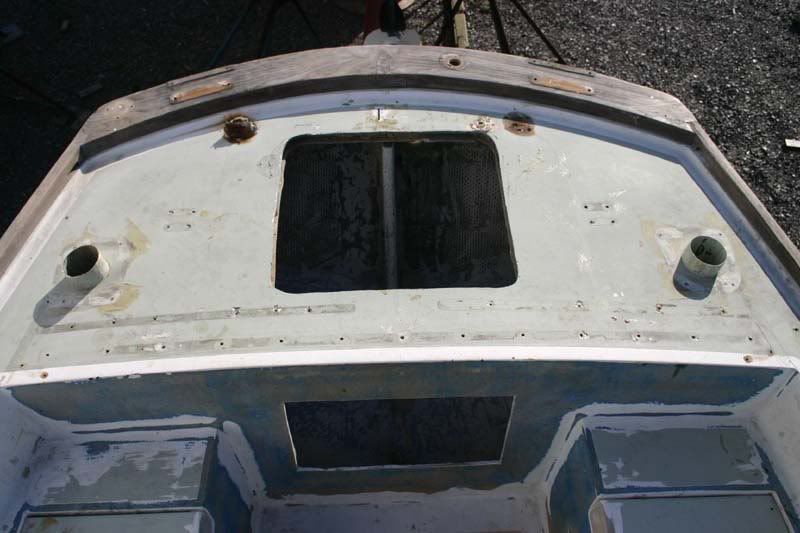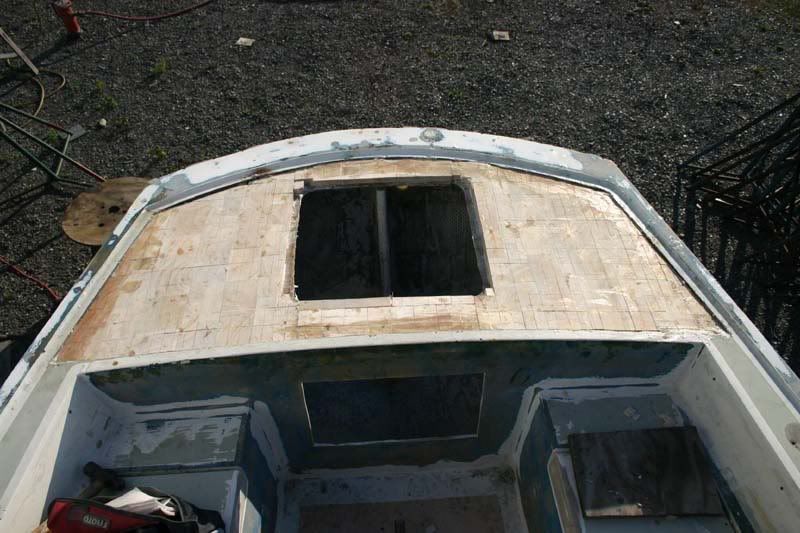Thursday was a beautiful warm sunny day. I had big plans but I got talking with a fellow boat restorer at the yard that I had not seen since last fall and we wound up catching up for a few hours. As he said, on the first warm day you really just want to bask in the sun like a couple of lizards.
I did get the battery shelves tabbed in with two layers of 14oz biax tape. The whole time I am thinking, "this is way overkill" but I am comfortable knowing that those shelves are going to hold the batteries for a long time. Even if the boat sails upside down for awhile...
Yesterday, the rain was supposed to start late so I had some small projects I was going to do. I got rained out after half an hour with nothing accomplished.
Today, it was supposed to rain hard all day but around 11 o-'clock the skies cleared and the sun came out so I changed plans and drove out to the boatyard.
Last fall I bought a 2 wheel drive pickup with some issues just so I would have something to work out of. I still don't drink or eat in the Honda and only once, in a dire emergency did I let a dog ride with me. Hey, it is my first nice car and I would like to keep it that way for awhile. Anyway... I keep a tool box in the truck permanently so I don't have to move the toolbox in and out every time I do some driveway car maintenance for someone (or myself) Having the extra tools handy has been nice. To make it even better I took out the passenger seat for more tool storage. Now I make fewer trips back to the house to get the tool I forgot. It is working out quite well having my own mobile shop.
Why did I start talking about this?.
ANYWAY...
Today, I installed my garboard drain plug since it was an easy job and warm enough for the 5200 sealant to set up. While I was at it I went ahead and installed a seacock for the engine raw water inlet. For my other seacocks I have used 3M 4200 so I could tell myself that I have a hope of removing the seacock if I ever needed to. Today I had a whole tube of 5200 and just the little garboard drain fitting so I went ahead and used the 5200 on the seacock as well. If I ever have to take the seacock out I am going to have to remove it with a grinder.
There is a mystery associated with my raw water engine intake. Originally, the water came in from the starboard side behind where the engine sits. The water pump is on the rear of the engine so it makes sense to locate it here. The original valve was not a seacock however. It was just a thru hull with a ball valve on top. This is done all the time but it is a bad practice. Thru-hulls use straight threads. Ball valves use tapered threads. The two types of threads don't go well together. You can force them together but I, being a mechanic by trade, have a hard time living with that. In addition, the through hull/ball valve setup is vulnerable to an impact from the side. A real seacock has a wide mounting surface that spreads the load to the hull much better. Seacocks are the only way to go.
So... I knew I was going to replace the thru-hull/ball valve setup. In addition, my engine had been converted to fresh water cooling so the raw water was being re-routed to the front of the engine where the new raw water pump was installed. It made sense to me to relocate the new seacock to a position closer to where the water needed to be- the front of the engine. That spot turns out to be where the galley drain is located on a Triton. I had already removed the galley drain since it was just a fiberglass tube 'glued' into the hull - also totally unsatisfactory.
This story is going on much too long.
Okay, so the mystery is this. After I launched I met up with two Triton owners and we cruised from Casco Bay to Penobscot Bay for a week. I was having overheating problems and it turned out my raw water strainer was getting plugged up with seaweed. Now, my two buddies have their raw water intakes in the original location. I was almost always traveling the same path give or take 100 feet or so. They had no problems all summer and I was cleaning out my strainer daily. Hmmm...
My best guess is that there was something about the water flow at the new location. The new location was about 3 feet further forward and slightly deeper that the original. It should have worked fine. Maybe the water swirls more at the aft location drawing the crap away from the intake. Maybe the water flowing by the hull in the new location sucks surface crap down into the path of my new intake location. We all had the same strainer/filter setups more or less. I had a problem they didn't. Are you confused too?...
So. My solution this time is to relocated the intake again. Today, I moved it to the port side and down in the keel section at least two and a half feet below the water line which is about another foot and a half further down than the original. I am thinking this should get me below the level of floating crap. If not then I will take it out and try again. Maybe I will just go back to the original location and run the water lines forward.

Pictures. Just one today. I didn't take any interior pictures since I am embarrassed about the condition of my bilge. My late model Triton has a deep open bilge that is difficult to get to and all sorts of crap falls down there as well as an entire summers worth of sanding dust which is now more like dried mud. Next week I plan on a thorough flush but for now I am not taking pictures :-)
I also did some planning as to the new routing of the water lines and mounting of the strainers along with new fuel system routing. I was thinking about moving the fuel filter/separator back by the new fuel tank along with the electric fuel pump but there wasn't room for both and it really didn't make sense to re-invent the wheel over this. I am going to stick with my last setup which keeps everything I need to service on the engine under the first step in the companionway in front of the engine. Tritons normally use this spot for the battery but I moved mine a couple of years ago closer to the engine starter and under the galley.
Finally, I did some measuring and tried to get back up to speed on the cabin sole project I left half done last fall. While I was doing this the rain came and I had to hurry up, button up, and skedaddle.
Next week, weather permitting the winter cover is coming off so I can finish the last bits of sanding and think about applying primer to the hull and decks. The cabin sole project is also high on the list for when my back gets tired of sanding.
Em Tasol.

































